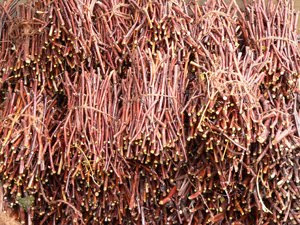Once the Root-stock's are grafted with vine cuttings (in our case - SHIRAZ and CHENIN BLANC) as we saw in our previous article, it becomes important that we setup a Nursery to house some rootstocks that may come handy to fill gaps - wherever the grafting has failed.
For this, we first make the "cuttings" ready which has at least 3 nodes and would be approximately 10 cms in length. Then we dip them in an anti-fungal solution to cleanse the rootsto ck and avoid any further fungal growth. Then these clean cuttings are put in a polythene bag, which comprises of mud soil and farm yard manure (FYM), in 80:20 proportion.
ck and avoid any further fungal growth. Then these clean cuttings are put in a polythene bag, which comprises of mud soil and farm yard manure (FYM), in 80:20 proportion.


To setup a Nursery:
1) Choose a reasonably flat land.
2) Have sufficient space to walk around.
3) Make sure water connection is close by -or water supplied using Sprinklers.
Shade-Net cloth of specific size is needed, which will allow minimum air in and maintain humidity of nursery. This can be stitched and can be used as top roof and side walls of nursery. These are supported by granite stone pillars, which acts as skeleton of nursery.
Once done the nursery would look something like this -
 It's a good practice to setup Sprinkler system for water irrigation within a nursery. This gives a rain kind of effect and helps in humidity too.
It's a good practice to setup Sprinkler system for water irrigation within a nursery. This gives a rain kind of effect and helps in humidity too.
Nursery needs to be supplied with water at least once in 2 days. This will make sure enough moisture is maintained and very soon the rootstock cuttings will start to sprout. Generally, it would need 3 weeks to show up new leaves, and constant watering is key for quick progress of rootstock plants.
All thinner plants are often segregated from good ones - and are given special attention with enough care to make sure budding happens eventually.
special attention with enough care to make sure budding happens eventually.
No special fertilizers treatment are required for root stocks, until unless we desire a lot of foliage in the plant.
The side walls of the nursery are pulled and tied at all corners to make sure it can withstand winds. A soft support system can be provided in the gap where the Shade net cloth touches every pole, to avoid friction and hence wear-tear of the cloth.
system can be provided in the gap where the Shade net cloth touches every pole, to avoid friction and hence wear-tear of the cloth.
 ck and avoid any further fungal growth. Then these clean cuttings are put in a polythene bag, which comprises of mud soil and farm yard manure (FYM), in 80:20 proportion.
ck and avoid any further fungal growth. Then these clean cuttings are put in a polythene bag, which comprises of mud soil and farm yard manure (FYM), in 80:20 proportion.

To setup a Nursery:
1) Choose a reasonably flat land.
2) Have sufficient space to walk around.
3) Make sure water connection is close by -or water supplied using Sprinklers.
Shade-Net cloth of specific size is needed, which will allow minimum air in and maintain humidity of nursery. This can be stitched and can be used as top roof and side walls of nursery. These are supported by granite stone pillars, which acts as skeleton of nursery.
Once done the nursery would look something like this -
 It's a good practice to setup Sprinkler system for water irrigation within a nursery. This gives a rain kind of effect and helps in humidity too.
It's a good practice to setup Sprinkler system for water irrigation within a nursery. This gives a rain kind of effect and helps in humidity too.Nursery needs to be supplied with water at least once in 2 days. This will make sure enough moisture is maintained and very soon the rootstock cuttings will start to sprout. Generally, it would need 3 weeks to show up new leaves, and constant watering is key for quick progress of rootstock plants.
All thinner plants are often segregated from good ones - and are given
 special attention with enough care to make sure budding happens eventually.
special attention with enough care to make sure budding happens eventually.No special fertilizers treatment are required for root stocks, until unless we desire a lot of foliage in the plant.
The side walls of the nursery are pulled and tied at all corners to make sure it can withstand winds. A soft support
 system can be provided in the gap where the Shade net cloth touches every pole, to avoid friction and hence wear-tear of the cloth.
system can be provided in the gap where the Shade net cloth touches every pole, to avoid friction and hence wear-tear of the cloth.